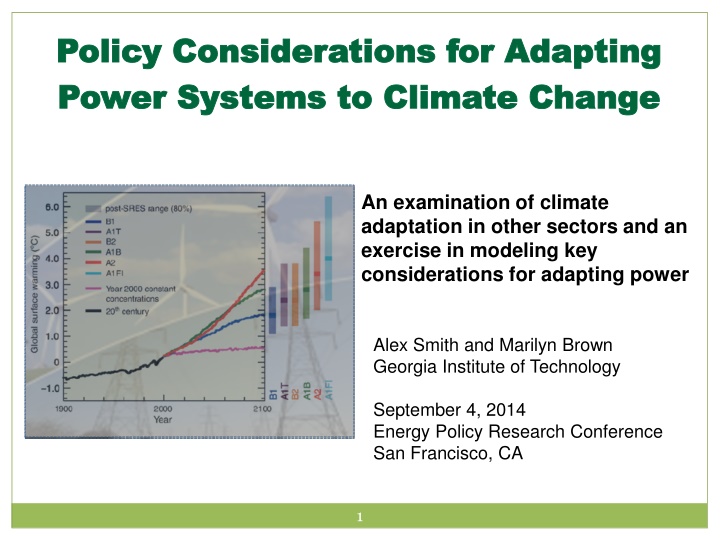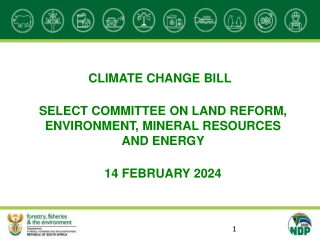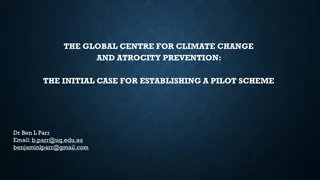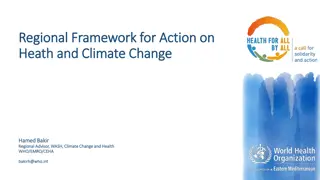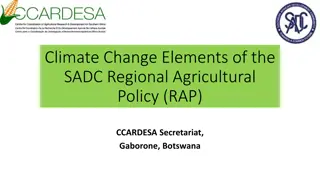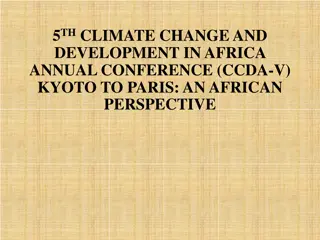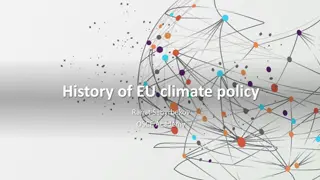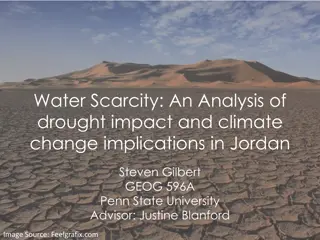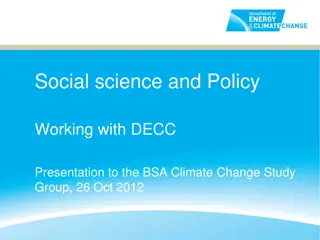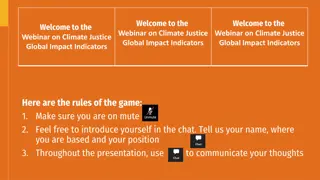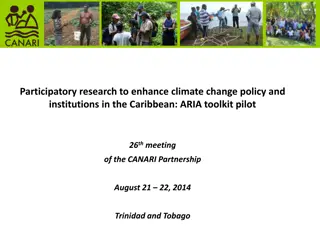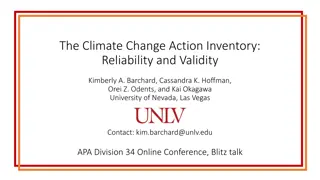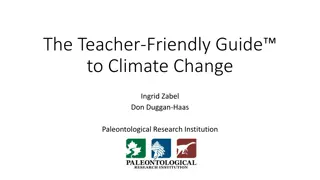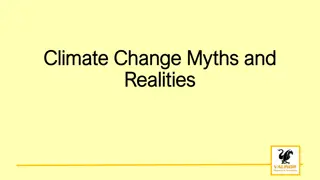Policy Considerations for Adapting Power Systems to Climate Change - Key Insights
Examining climate adaptation in various sectors provides valuable lessons for adapting power systems. Considerations include resiliency, broad impact assessment, local knowledge integration, and balancing multiple policy goals.
Download Presentation

Please find below an Image/Link to download the presentation.
The content on the website is provided AS IS for your information and personal use only. It may not be sold, licensed, or shared on other websites without obtaining consent from the author.If you encounter any issues during the download, it is possible that the publisher has removed the file from their server.
You are allowed to download the files provided on this website for personal or commercial use, subject to the condition that they are used lawfully. All files are the property of their respective owners.
The content on the website is provided AS IS for your information and personal use only. It may not be sold, licensed, or shared on other websites without obtaining consent from the author.
E N D
Presentation Transcript
Policy Considerations for Adapting Policy Considerations for Adapting Power Systems to Climate Change Power Systems to Climate Change An examination of climate adaptation in other sectors and an exercise in modeling key considerations for adapting power Alex Smith and Marilyn Brown Georgia Institute of Technology September 4, 2014 Energy Policy Research Conference San Francisco, CA 1
What can Power Sector Resiliency What can Power Sector Resiliency Thinking Learn from Other Sectors? Thinking Learn from Other Sectors? 2 Resiliency a new priority in utility thinking Robustness to unforeseen changes disturbances In short-term trends, e.g. extreme weather in long-term trends, e.g. average temperature How do we model ever-more-uncertain futures? Many utility resiliency analyses focus on large infrastructure projects, typical for utilities E.g. PSE&G s post-sandy grid hardening plan Proposed as $3.9 Billion paid for in one year by ratepayers1
Climate Adaptation Literature Calls for a Climate Adaptation Literature Calls for a Broad Focus Broad Focus in Assessing Potential Impacts in Assessing Potential Impacts 3 Prior experience in other sectors and other parts of the world offer lessons for future adaptation actions Maladaptation: Large infrastructure investments can create maladaptation outcomes by Constraining resources available for meeting future unforeseen challenges - imposing path dependency 2 Discouraging individual actors from adapting3 Contributing to further climate change via GHG emissions4 Burdening those already most vulnerable, e.g. low-income ratepayers facing riders and tariffs for cost recovery5
Consideration of Local Knowledge and Consideration of Local Knowledge and Other Policy Goals Also Important Other Policy Goals Also Important 4 Climate adaptation is a local problem, requiring local solutions, requiring local knowledge Market-based instruments are lauded for promoting such knowledge integration3,6 Command-and-control policies can also develop local knowledge by fostering innovation to meet standards7 But standards create risks of prescribing adaptive measures that do not universally work3,6 Non-adaptive goals foster adaptive action Much private adaptation measures taken due to co-benefits8 Much adaptation policy justified via economic development or resource management goal9
Existing Tools can be Used to Account Existing Tools can be Used to Account for these Important Considerations for these Important Considerations 5 Our study demonstrates one way of taking these adaptation considerations into account We use an existing computable general equilibrium model, GT_NEMS, based upon EIA s NEMS We develop a scenario of demand disturbance representative of a potential effect of climate change To the demand disturbance scenario, we introduce a measure expected to enhance adaptive capacity We examine multiple outcomes from this scenario in order to assess the measure in light of the multiple considerations outlined by the climate adaptation literature
GT_NEMS Requires some Adjustment GT_NEMS Requires some Adjustment to Model Demand Disturbances to Model Demand Disturbances 6 GT_NEMS is a computable general equilibrium model based upon EIA s NEMS Used to simulate US energy economy Performs optimization in iterations until solutions converge Reference case run matches AEO 2014 to greater than 99% GT_NEMS uses perfect foresight in power planning, challenging disturbance modeling Electric capacity built based upon expected demand Actual outcomes of prior iterations are used as expected demand Thus expectations of final iteration are perfect (match demand) Thus, it is difficult to surprise GT_NEMS power sector model with unforeseen changes in demand
We Introduce a We Introduce a D Demand Disturbance emand Disturbance and an Adaptive Measure to GT_NEMS and an Adaptive Measure to GT_NEMS 7 Substitute perfect expectations for myopic expectations of electricity demand growth Base expectations upon prior two-year trend in demand Overwrite myopic expectations with under-expectations of electricity demand growth Use EIA s Low Macroeconomic Growth case s results as expectations Average annual demand growth 0.5% less than in the reference case Capacity planning thus expects less demand than it will encounter Introduce High Tech assumptions as adaptive measure EIA s Integrated High Efficiency Demand Technology side case Accelerated building code compliance for both residential and commercial buildings; across-the-board improvements in efficiency and cost-effectiveness of electricity end-use technologies10 Chosen in part because efficiency has been advocated for adaptation3,11
Reference Case Demand Exceeds Reference Case Demand Exceeds Expectations, Creating Disturbance Expectations, Creating Disturbance 8 Degree of demand under-expectation varies by sector Uniform across nation; cannot program region-specific expectations Gap between demand and expectations for the commercial and residential sectors are greater in the US South
Disturbance Places Premium on Low Disturbance Places Premium on Low- -cost, Flexible Flexible- -utilization Capacity Resources utilization Capacity Resources cost, 9 Coal plants are rapidly retired and disappear by 2040, mostly due to the disturbance alone Combined cycle and combustion turbines become preferred resources ramping, low-cost capacity
Disturbance Scenario Disturbance Scenario E Exhibits Improved Energy Efficiency of US Economy Energy Efficiency of US Economy xhibits Improved 10 Disturbance drives a ~5% decrease in energy intensity of US economy signaling improved
Disturbance Drives Reduction in Carbon Disturbance Drives Reduction in Carbon Emissions, Augmented by Efficiency Emissions, Augmented by Efficiency 11 Disturbance reduces carbon emissions, primarily caused by energy efficiency and fuel-switching; efficiency augments this effect
Small Losses in Real GDP & Value of Small Losses in Real GDP & Value of Shipments; Efficiency Helps Recovery Shipments; Efficiency Helps Recovery 12 Disturbance + High Tech 1,899 (Billion $2005) Reference High Tech Disturbance 2020 1,932 1,933 1,897 Energy- Intensive Industries VOS 2025 2,082 2,082 2,037 2,060 2030 2,171 2,171 2,121 2,152 2035 2,237 2,239 2,188 2,209 Non- Energy- Intensive Industries VOS 2020 3,804 3,805 3,746 3,744 2025 4,386 4,385 4,319 4,392 2030 4,975 4,975 4,911 5,056 2035 2020 5,542 16,753 5,547 16,758 5,489 16,681 5,652 16,662 US Gross Domestic Product 2025 18,770 18,772 18,676 18,727 2030 21,136 21,143 21,032 21,147 2035 23,747 23,758 23,619 23,733
The Disturbance Increases Electricity The Disturbance Increases Electricity Prices; Efficiency has Little Added Effect Prices; Efficiency has Little Added Effect 13 High Tech Disturbance + High Tech Reference Disturbance ($/kWh) 2020 2025 2030 0.1236 0.1237 0.1268 0.1232 0.1232 0.1264 0.1294 0.1343 0.1411 0.1315 0.1348 0.1418 Residential Demand 2035 0.1295 0.1291 0.1491 0.1481 2020 2025 2030 0.1054 0.1046 0.1073 0.1050 0.1042 0.1069 0.1115 0.1157 0.1217 0.1122 0.1141 0.1216 Commercial Demand 2035 0.1096 0.1091 0.1296 0.1286 2020 2025 2030 2035 0.0710 0.0722 0.0754 0.0785 0.0708 0.0720 0.0753 0.0784 0.0774 0.0831 0.0906 0.0989 0.0775 0.0802 0.0880 0.0961 Industrial Demand
Disturbance Reduces Non Disturbance Reduces Non- -carbon Pollution Pollution; ; Efficiency has Minor Effects Efficiency has Minor Effects carbon 14 Disturbance causes other pollutant emissions decline, consequence of coal capacity retirements Measure slightly accelerates this effect
More Work to be Done, but Holistic More Work to be Done, but Holistic Assessment of Adaptation is Feasible Assessment of Adaptation is Feasible 15 Have demonstrated that existing tools can be used to address important adaptation considerations Further work will examine models of path-dependent systems Also, alternate adaptation measures (e.g. transmission builds) Also, alternate disturbances (e.g. water shortages) Current and future analyses will be embellished via calculation of costs of measure-creation What are the costs of advancing technology for adaptation? We hope to inspire further work into forming holistic assessments of adaptation options Alternate methods should be considered, such as stakeholder- driven modeling and multi-criteria decision making analyses
For More Information For More Information 16 Alexander M. Smith School of Public Policy Georgia Institute of Technology Atlanta, GA 30332-0345 asmith313@gatech.edu Marilyn A. Brown School of Public Policy Georgia Institute of Technology Atlanta, GA 30332-0345 Marilyn.Brown@pubpolicy.gatech.edu Climate and Energy Policy Lab: http://www.cepl.gatech.edu
Reference List Reference List 17 Lacey, Stephen (2014) Resiliency: How Superstorm Sandy changed America s Grid. GreenTech Media report, Boston, Massachusetts, USA. Accessed 07/25/2014 from http://www.greentechmedia.com/articles/featured/resiliency-how-superstorm-sandy-changed-americas-grid Filatova, T. (2014) Market-based instruments for flood risk management: A review of theory, practice, and perspectives for climate adaptation policy. Environmental Science & Policy, 37, 227-242 Barnett, J.; O Neill,S. (2010) Maladaptation. Global Environmental Change, 20, 211-213 Vine, E. (2012) Adaptation of California s electricity sector to climate change. Climatic Change, 111, 75-99. DOI: 10.1007/s10584-011-0242-2 National Action Plan for Energy Efficiency (2007) Aligning utility incentives with investment in energy efficiency. Prepared by Val R. Jensen, ICF International. www.epa.gov/eeactionplan Saintilan, N.; Rogers, K.; and Ralph, T.J. (2013) Matching research and policy tools to scales of climate-change adaptation in the Murray-Darling, a large Australian river basin: A review. Hydrobiologia, 708, 97-109. DOI: 10.1007/s10750-011-0970-3 Fu, Y. et al. (2012) Climate change adaptation among Tibetan pastoralists: Challenges in enhancing local adaptation through policy support. Environmental Management, 50, 607-621. DOI: 10.1007/s00267-012-9918-2 Tompkins, E.L., et al. (2010) Observed adaptation to climate change: UK evidence of transition to a well-adapting society. Global Environmental Change, 20, 627-635. DOI: 10.1016/j.gloevncha.2010.05.001 Aggarwal, R.M. (2013) Strategic bundling of development policies with adaptation: An examination of Delhi s climate change action plan. International Journal of Urban and Regional Research, 37(6), 1902-1915. DOI: 10.1111/1468-2427.12032 US Energy Information Administration (2014) Annual Energy Outlook 2014. Accessed June 15 from http://www.eia.gov/forecasts/aeo/pdf/0383(2014).pdf US Congressional Budget Office (2012) Energy security in the United States. Washington, District of Columbia, USA. Accessed June 05, 2012 from http://www.cbo.gov/sites/default/files/cbofiles/attachments/05-09- EnergySecurity.pdf
